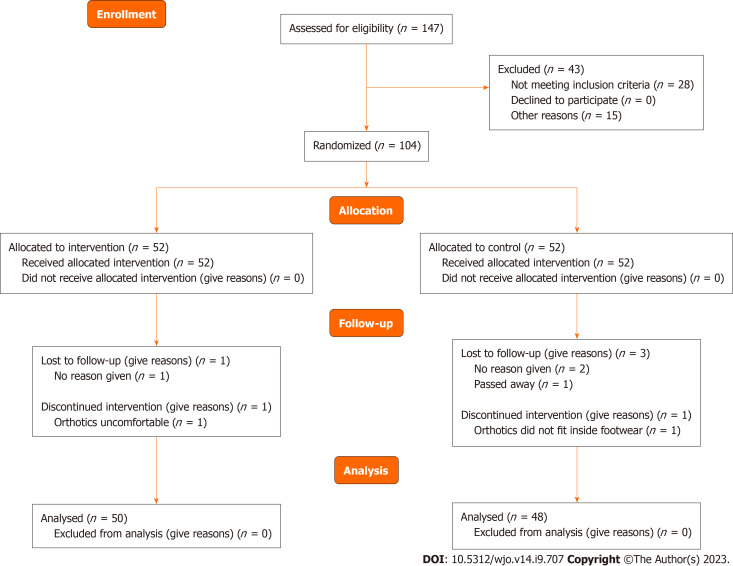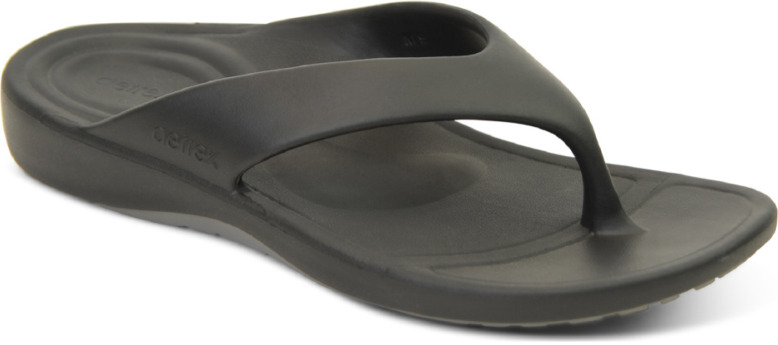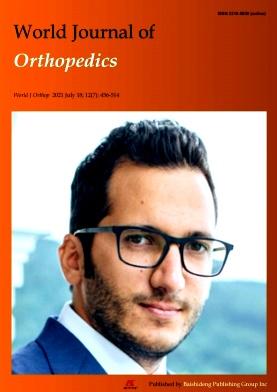Use of orthotics with orthotic sandals versus the sole use of orthotics for plantar fasciitis: Randomised controlled trial.
IF 2
Q2 ORTHOPEDICS
引用次数: 0
Abstract
BACKGROUND Plantar fasciitis (PF) affects around 10% of the population. Prefabricated orthotics with arch support has been shown to provide symptom relief in PF by decreasing the repetitive stress sustained by the plantar fascia. However, prefabricated orthotics are only effective when shoes are worn, meaning the foot may be left unsupported when it is impractical to wear shoes. Using orthotic sandals in conjunction with prefabricated orthotics may increase PF symptom relief, as they can be worn inside the home, extending the period in which the foot is supported. AIM To compare the combined use of prefabricated orthotics and orthotic sandals vs the sole use of prefabricated orthotics in the treatment of PF. METHODS 98 participants with PF were randomised into two groups. The intervention group received the Aetrex L420 Compete orthotics and the Aetrex L3000 Maui Flips (orthotic sandals), whilst the control group received the Aetrex L420 Compete orthotics only. Foot pain was assessed both by the numerical rating scale (NRS) and the pain sub-scale of the foot health status questionnaire (FHSQ). Foot functionality was measured using the function sub-scale of the FHSQ. Symptom change was measured using the global rating of change scale (GROC). RESULTS Foot pain scores measured both by NRS and FHSQ pain sub-scale showed statistically significant reductions in foot pain in both groups (P < 0.05) at six months. Both groups also reported statistically significant improvements (P < 0.05) in function as measured by the FHSQ function subscale and improvement of symptoms as measured by the GROC scale. Between-group analysis showed that the intervention group with the combined use of orthotics and orthotic sandals scored better on all four outcome measures as compared to the control group with the sole use of orthotics. However, the between-group analysis only reached statistical significance on the NRS pain score (P < 0.05). CONCLUSION Combined use of prefabricated orthotics and orthotic sandals provides a greater decrease in foot pain and improvement in foot function in PF compared to using prefabricated orthotics alone.



矫形器与矫形器凉鞋的使用与足趾筋膜炎矫形器的单独使用:随机对照试验。
背景:足底筋膜炎(PF)影响大约10%的人口。具有足弓支撑的预制矫形器已被证明可以通过减少足底筋膜承受的重复应力来缓解PF的症状。然而,预制矫形器只有在穿鞋时才有效,这意味着当穿鞋不切实际时,脚可能没有支撑。将矫形器凉鞋与预制矫形器结合使用可能会增加PF症状的缓解,因为它们可以在家里穿着,延长足部支撑的时间。目的:比较预制矫形器和矫形器凉鞋联合使用与单独使用预制矫形剂治疗PF的疗效。方法:98名PF患者被随机分为两组。干预组接受了Aetrex L420 Compete矫形器和Aetrex L3000 Maui Flips(矫形器凉鞋),而对照组仅接受了Aetrix L420 Compete矫形器。足部疼痛通过数字评定量表(NRS)和足部健康状况问卷(FHSQ)的疼痛子量表进行评估。使用FHSQ的功能子量表测量足部功能。结果:NRS和FHSQ疼痛亚量表测量的足部疼痛评分显示,两组在6个月时的足部疼痛均有统计学意义的减轻(P<0.05)。两组还报告了FHSQ功能分量表测量的功能和GROC量表测量的症状改善的统计学显著性改善(P<0.05)。组间分析显示,与单独使用矫形器的对照组相比,联合使用矫形剂和矫形器凉鞋的干预组在所有四项结果指标上得分更好。然而,组间分析仅对NRS疼痛评分具有统计学意义(P<0.05)。
本文章由计算机程序翻译,如有差异,请以英文原文为准。
求助全文
约1分钟内获得全文
求助全文

 求助内容:
求助内容: 应助结果提醒方式:
应助结果提醒方式:


